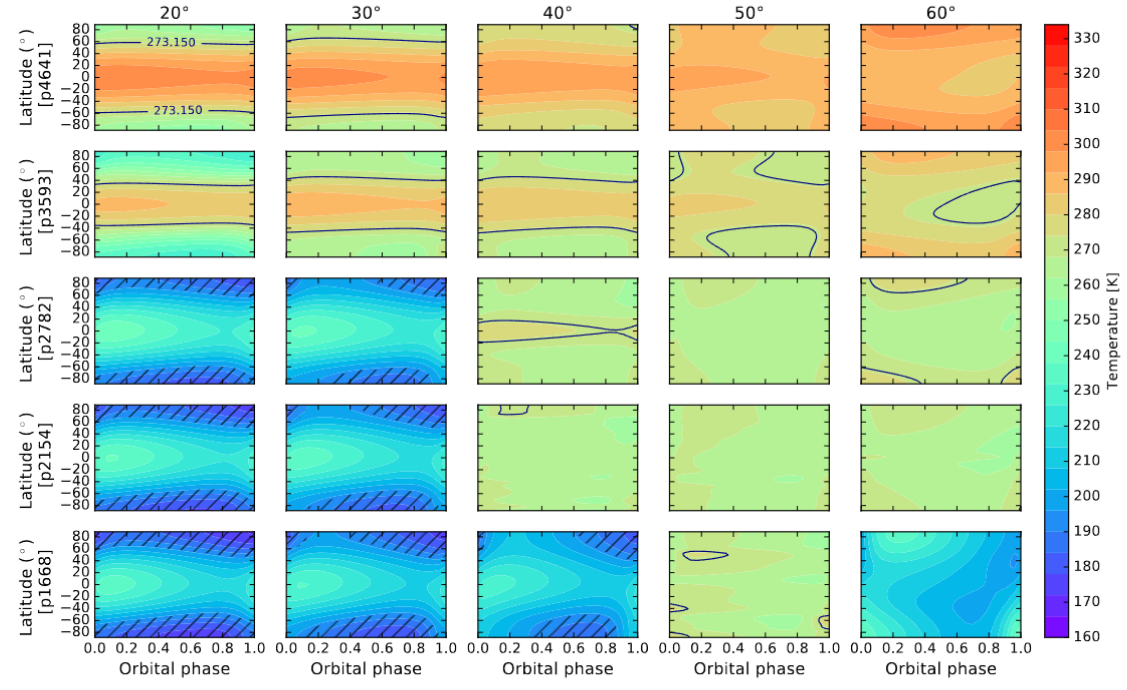- 1Department of Physics, University of Trieste, Trieste, Italy
- 2Trieste Astronomical Observatory, INAF, Trieste, Italy
- 3Torino Astrophysical Observatory, INAF, Torino, Italy
Introduction: The recently discovered super-Earth planet Gl 514 b, orbiting the nearby (7.6 pc, [1]) M-dwarf, is an interesting case to explore the habitability of planets that radically differ from the Earth. Habitability studies often rely on the classic definition of the Habitable Zone (HZ), and in particular on the so-called Conservative Habitable Zone (CHZ, [2]). Due to the combination of its relatively large semi-major axis (a=0.42 AU) and eccentricity (e=0.45), Gl 514b lies part of the time inside the CHZ (about 34% of the orbital period) and the rest of the time beyond the outer edge of the CHZ. This suggests the presence of strong seasonal variations that impact the actual habitability of the planet. Tracking the seasonal evolution of habitability is not possible using the HZ approach and requires the application of seasonal climate models tailored for specific stellar, orbital and planetary parameters.
Investigating the potential climates of planets that exhibit seasonal episodes of habitability is intriguing because it could provide insights into the dynamic nature of planetary systems and the potential for the support of life in exotic scenarios. In this sense, the study of the habitability of Gl 514 b can be generalized to all that cases in which there are strong instellation variations, thus helping to define a “Seasonal Habitable Zone”.
The Model: In our study we use the climate model, EOS-ESTM [3,4] for exploring the habitability of Gl 514 b by calculating an index of surface habitability based on the surface temperature distribution. In practice, we explore the habitability as a function of climate factors currently unconstrained by the observations (e.g., Fig 1), such as the ocean cover fraction, the obliquity, and the atmospheric composition. We consider three different types of atmospheres: (i) CO2-dominated, (ii) CO2 + 0.1% CH4 and (iii) CO2 + 1.0% CH4.
Since transits of Gl 514 b have not been detected so far, we estimate the radius and the surface gravity from interior structure models (e.g. [5]) and from the measurements of the minimum mass (5.2 M⊕). The high eccentricity of Gl 514 b suggests that the system is dynamically young and that spin-orbit tidal synchronization may not have yet occurred (e.g. [6]). Assuming that the planet is not tidally locked, in this contribution we present results obtained for a rotation of 1 day (see full paper for complete set of tests).
Results: In the present work, we show how the habitability of Gl 514b is impacted by different combinations of planetary, orbital and atmospheric parameters. The impact of the ocean cover fraction is significant due to the orbit of Gl 514 b (see Figure 1). In fact, the large thermal capacity of even a 25-m shallow ocean provides sufficient thermal inertia to avoid freezing conditions near apoastron. Similarly, the obliquity plays a fundamental role in seasonal habitable events. The higher the obliquity of the planet, the greater the thermal excursion to the poles is (see Figure 2). Nonetheless, we show that these effects are regulated by the total surface pressure and the content of methane in the atmosphere. We present results of the parameter space that allows conditions of continuous and transient habitability.

Figure 1. Predicted values of the habitability index, ℎ, as a function of the ocean cover fraction and total surface pressure for three different atmospheric
compositions. Left panel: CO2-dominated; middle panel: CO2+ 0.1% CH4; right panel: CO2+ 1% CH4. For the remaining parameters we adopt 𝜖 =23.44◦,
𝑃𝑟𝑜𝑡 =1 day and 𝜔𝑝𝑒𝑟𝑖 =0◦. The dashed areas indicate the parameter space in which atmospheric CO2 condensates.

Figure 2. Seasonal and latitudinal maps of surface temperature obtained by extracting the results of Fig. 9c (case with 1% CH4) at constant values of axis obliquity (from left to right: 𝜖 = 20◦ , 30◦ , 40◦ , 50◦, and 60◦) and total pressure (from top to bottom: 𝑝𝑡𝑜𝑡 =5 464, 3 593, 2 782, 2 154, and 1 668 mbar). The solid line indicate the limit within which water can be maintained in liquid form.
Further investigations will include the impact of the host star on the exoplanet environment, especially concerning the photochemical reactions in the atmosphere driven by the large UV flux of the parent star. Apart from the direct impact on habitability due to its ionizing effects, the radiation environment of Gl 514 b may be conductive to the presence of high-altitude organic hazes that directly affect the climate state of the planet.
References:
[1] Damasso M., et al., 2022, A&A, 666, A187.
[2] Kopparapu R. K., et al., 2013, ApJ, 765, 131.
[3] Simonetti P., et al., 2022, ApJ, 925, 105.
[4] Biasiotti L., et al., 2022, MNRAS, 514, 5105.
[5] Fortney J. J., Marley M. S., Barnes J. W., 2007, ApJ, 659, 1661.
[6] Barnes R., 2017, Celestial Mechanics and Dynamical Astronomy, 129, 509.
[7] Damasso M., Nardiello D., 2022, Research Notes of the American Astronomical Society, 6, 184
How to cite: Biasiotti, L., Simonetti, P., Vladilo, G., Ivanovski, S., Damasso, M., Sozzetti, A., and Monai, S.: Potential climate and habitability of Gl 514 b, Europlanet Science Congress 2024, Berlin, Germany, 8–13 Sep 2024, EPSC2024-393, https://doi.org/10.5194/epsc2024-393, 2024.